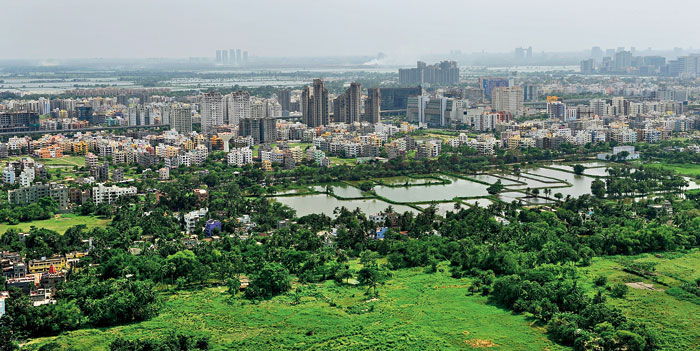The name Rajarhat came from the words “raja”, meaning king, and “haat”, meaning marketplace, in Bengali. Historian Haripada Bhowmick had come to New Town’s Rabindra Tirtha and explained to the audience the etymology and history behind the township.
“The name of Rajarhat came about in 1649 when Gourhari Ray Chaudhury decided to start a market in the area. He was the son of Lakshmikanta Gangopadhyay of the Sabarna Ray Chaudhury family. In 1608, Raja Man Singh had given Gangopadhyay zamindari of five parganas from Barrackpore to Gangasagar. They were the tax-collectors (majumdar) and revered as kings,” explained Bhowmick.
Present-day Rajarhat was already inhabited in those days but it got a new lease of life once Ray Chaudhury started developing it. “The name Rajarhat was given to just the spot where the market came up but it spread to include the area surrounding it. Much like how Nadia, which is now a district, was once a spot where a tantrik meditated by lighting nine (nau) diyas,” said Bhowmick.

Historian Haripada Bhowmick had come to New Town’s Rabindra Tirtha and explained to the audience the etymology and history behind the township Sudeshna Banerjee
But after Ray Chaudhury’s demise, his son moved out of their residence in Nimta, Birati, to Barisha, Behala in 1716. From then on, Rajarhat suffered from neglect for the next few centuries.
In the 20th century, development was held back due to lack of connectivity. “The only transport in and out of Rajarhat then was on bullock carts. Buses that left Shyambazar couldn’t reach Baguiati or Rajarhat as the Bagjola Canal came in the way,” Bhowmick explained.
The turning point came in 1956 when a bridge was built over the canal between Baguiati and Dakhinpara, near Nagerbazar. “A bus service started between Shyambazar and Baguiati, touching Rajarhat. The bus route had no number but the fare was two annas.”
The bus had to be stopped due to lack of passengers but the 30C bus route started in 1965 after VIP Road got built. This would enter Hatiara, which, if travelling towards the airport from Ultadanga, is the region on the right, opposite Baguiati. “This 30C bus number still exists but the route no longer enters Rajarhat. From then on started the real development of this area,” smiled Bhowmick.
Bhowmick’s speech had to be cut short for lack of time but many from the audience followed him as he descended from stage to ask for some more nuggets.
“The enthusiasm to read has dwindled now-a-days but not the enthusiasm to learn,” said Bhowmick, in between answering questions. “History isn’t boring. It is just a story that puts to context our present. And we need to respect it.”











